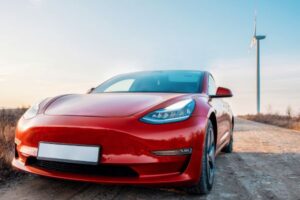The automotive landscape is undergoing a paradigm shift, with electric sports cars leading the charge towards a sustainable and exhilarating future of high-performance motoring. As electric vehicles (EVs) gain momentum, the focus on enhancing the in-car experience has never been more pronounced. In 2023, infotainment systems in electric sports cars have evolved beyond mere entertainment hubs; they are intelligent, interconnected interfaces that seamlessly integrate technology, connectivity, and driving information. These cutting-edge systems redefine the driving experience, setting new standards of convenience, safety, and engagement for drivers and passengers alike.
The infotainment systems of 2023’s electric sports cars exemplify the symbiosis of automotive engineering and digital innovation. Advanced interactive displays with haptic feedback, augmented reality (AR) head-up displays (HUDs), and gesture controls transform the driving cockpit into an intuitive and immersive environment. Beyond offering entertainment and navigation, these systems provide vital real-time driving information, enhancing safety and situational awareness on the road.
Seamless connectivity and smart integration have become integral to infotainment systems in 2023’s electric sports cars. Leveraging vehicle-to-vehicle (V2V) and vehicle-to-infrastructure (V2I) communication, electric sports cars interact with other vehicles and traffic infrastructure, providing real-time updates on road conditions and traffic patterns. Moreover, these infotainment systems flawlessly integrate with smartphones and wearable devices, enabling drivers to access their preferred apps and services with ease while staying connected and informed on the go.
Voice assistants powered by advanced natural language processing (NLP) technology serve as intelligent companions within 2023’s electric sports cars. Through seamless voice commands, drivers can interact with the infotainment system, control various functions, and access driving information without taking their eyes off the road. The fusion of voice assistants and NLP not only enhances convenience but also elevates safety, as it minimizes the need for manual input and distractions while driving.
The customization and personalization of user profiles represent yet another aspect of the evolution of infotainment systems. In 2023’s electric sports cars, these systems store multiple driver profiles in the cloud, allowing each driver to have their settings, preferences, and connected accounts automatically synced to the infotainment system when they step into the vehicle. These personalized profiles ensure a tailored experience for every driver, encompassing everything from seat adjustments to music preferences, creating an environment that feels uniquely their own.
Furthermore, the evolution of infotainment systems in electric sports cars is not limited to the initial design and deployment. Over-the-air updates play a vital role in future-proofing these systems, enabling continuous improvement and the integration of new features and functionalities. Manufacturers can deliver software upgrades directly to the infotainment system, ensuring that electric sports cars remain up-to-date with the latest technology, security enhancements, and regulatory compliance.
As electric sports cars continue to push the boundaries of automotive engineering and digital innovation, the role of infotainment systems becomes increasingly critical in shaping the driving experience. From immersive displays to intelligent voice assistants and seamless connectivity, these systems exemplify the automotive industry’s commitment to elevating the high-performance motoring journey into an unparalleled realm of excitement, convenience, and sustainability. The comparative study of infotainment systems in 2023’s electric sports cars offers a glimpse into the thrilling and connected driving experience of tomorrow, where cutting-edge technology converges with the spirit of high-performance motoring on the roads of the future.
Advanced Interactive Displays and Gesture Controls
In 2023’s electric sports cars, infotainment systems have transcended traditional user interfaces. Advanced interactive displays and gesture controls offer drivers and passengers an intuitive and immersive experience. High-resolution touchscreens with haptic feedback provide seamless navigation through menus and functions, while gesture controls enable drivers to perform specific tasks with simple hand movements, reducing distraction and ensuring safer driving.
These interactive displays are not limited to the central console; electric sports cars often feature augmented reality (AR) head-up displays (HUDs) that project essential driving information onto the windshield. With AR HUDs, drivers can access real-time navigation, speed, and safety alerts while keeping their eyes on the road, enhancing the overall driving experience and contributing to a safer, more informed journey.
Seamless Connectivity and Smart Integration
In 2023’s electric sports cars, infotainment systems are synonymous with seamless connectivity and smart integration. Vehicle-to-vehicle (V2V) and vehicle-to-infrastructure (V2I) communication capabilities allow electric sports cars to interact with other vehicles and traffic infrastructure, providing real-time updates on traffic conditions, road hazards, and suggested alternative routes.
Moreover, these infotainment systems seamlessly integrate with smartphones and wearable devices, allowing drivers to access their preferred navigation apps, music libraries, and voice assistants with ease. The integration of popular applications and services ensures that drivers remain connected and informed without compromising their focus on the road.
Voice Assistants and Natural Language Processing
Voice assistants have become an integral part of infotainment systems in 2023’s electric sports cars. Powered by advanced natural language processing (NLP) technology, these voice assistants understand and respond to natural speech, allowing drivers to interact with the infotainment system using conversational commands. Drivers can control various functions, such as adjusting the climate settings, changing music tracks, or accessing navigation instructions, simply by speaking naturally.
These voice assistants also play a crucial role in enhancing driver safety. By minimizing the need for manual input and touch-based controls, drivers can keep their hands on the steering wheel and their attention on the road. Furthermore, NLP technology continually improves through machine learning, ensuring that voice assistants become even more intuitive and accurate over time.
Personalization and User Profiles
In 2023’s electric sports cars, infotainment systems offer a high degree of personalization and user profiles. With multiple driver profiles stored in the cloud, each driver can have their settings, preferences, and connected accounts automatically synced to the infotainment system when they enter the vehicle.
These personalized profiles extend beyond the typical settings; they encompass everything from preferred seat adjustments and climate settings to music preferences and frequently visited locations. As electric sports cars become a hub for shared mobility services, these personalized user profiles ensure a seamless transition between different drivers, creating a tailored and enjoyable experience for everyone.
Over-the-Air Updates and Future-proofing
The evolution of infotainment systems in 2023’s electric sports cars does not end with the initial design and deployment. Continuous improvement and future-proofing are achieved through over-the-air updates. Manufacturers can deliver software upgrades and new features directly to the infotainment system, ensuring that electric sports cars remain up-to-date with the latest technology and functionalities.
These over-the-air updates not only enhance the user experience but also address security vulnerabilities and ensure compliance with evolving regulations. As the automotive industry embraces a more digital and connected future, over-the-air updates become a crucial component in optimizing and maintaining the performance and security of infotainment systems.
Conclusion
The infotainment systems in 2023’s electric sports cars redefine the in-car experience, merging entertainment, connectivity, and intelligence into a seamless and intuitive interface. Advanced interactive displays and gesture controls enhance user engagement, while seamless connectivity and smart integration keep drivers informed and connected on the go. Voice assistants with natural language processing technology offer an unprecedented level of convenience and safety, allowing drivers to interact with the infotainment system through natural speech. The personalization of user profiles ensures that each driver enjoys a tailored experience, while over-the-air updates future-proof the infotainment system, enabling continuous improvement and optimization.
As electric sports cars continue to evolve, the role of infotainment systems in shaping the driving experience will become increasingly pronounced. The fusion of technology, connectivity, and entertainment in these systems exemplifies the automotive industry’s relentless pursuit of elevating high-performance motoring to new heights of excitement and convenience. From augmented reality displays to intelligent voice assistants, the future of infotainment systems in electric sports cars holds the promise of a thrilling and connected driving journey, where innovation and exhilaration coexist in perfect harmony.



